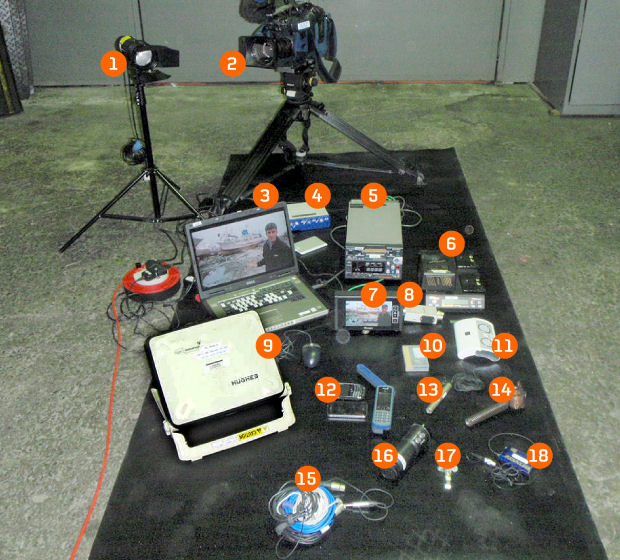Technical kit for Japan’s tsunami zone
Channel 4 News cameraman Stuart Webb empties his kit bag ahead of a return to Japan’s tsunami zone and explains what each piece of equipment does.

1) Light
Travelling light to film indoor interviews. They also came in handy during the tsunami to light the backdrop during the live outdoor broadcasts – had to be run off generators.
2) Camera and tripod
At Channel 4 News we use a Panasonic DVC Pro Camera. This camera films onto digital tape which you then load or “ingest” onto a laptop computer for editing.
I’m often asked “why do they need to be so big” – especially with technology making everything smaller.
Well they do need to be that big for some important reasons. A small camera is difficult to keep steady as even your body movement or breathing can move the shot especially when you are zoomed in over a long distance – but the large pro camera is very well balanced and weighted so well that when it’s on your shoulder your whole body can act like a tripod and you can hold a steady shot even when zoomed-in over a long distance.
The lens is also heavy and long and needs to be counter-balanced by the weight and length of an appropriate camera body. The camera is also very robust and made to take knocks, housed as it is in a solid aluminium body, so it can take filming in the middle of a riot, conflict, or tsunami. Smaller cameras can break easily or succumb to the elements.
Most of the world’s news organisations use the British-made Vinton tripods. Unfortunately, like the camera, they need to be heavy for the same reasons – to hold very steady shots on rough ground over long distances – and be robust too.
3) Laptop
All the raw footage or “rushes” are loaded onto a laptop computer and the final broadcast report is edited using a programme called Avid.
4) MBox
This is sound mixer – it’s an extra device for the laptop to ensure the sound is cleaner and more useable.
5) Tape player
The tape can be loaded onto the computer directly from the camera or via a tape player. During the tsunami I used my tape player to load, which meant I still had my camera close at hand to film with.
6) Battery charger
This recharges the camera batteries – not impressive but crucial. If it broke there would be no other way charge the batteries because they are so specific.
7) Monitor
To help with the edit we use a monitor and travel speakers. The time pressure for our deadline during the tsunami was so critical we never had time to find a room to edit in – so we ended up editing in the reception areas of hotels and in a Starbucks. I’ve also edited in open fields – and even in the boots of cars!
8) Prospect box
This device allows the reporter, when doing a live, to hear the studio in London. During a live he or she will be attached to the prospect box via an earpiece which will be attached to the laptop which will be attached to the Bgan.
9) Bgan
This is a satellite communications device. You can just use it as a satellite phone – but for our purposes we use it to feed our reports back to London and do lives with.
On the first two nights of our tsunami coverage we produced two one-hour live programmes from the heart of the disaster zone.
The whole broadcast was done using Bgans. Governments who don’t want journalists coming in to report what’s going on search high and low for Bgans. During the Arab Spring all the affected countries tried to prevent Bgans getting in.
10) Tapes
We carry dozens of tapes to record raw footage and interviews.
11) Speakers
These amplify the sound because the speakers in the computer aren’t powerful enough.
12) Communication
We use normal iPhones and Blackberries but in a disaster zone when communications have been knocked out we also use hand-held satellite phones.
13) Tie microphone
We use these in controlled environment often for what is called a “sit down” interview.
14) Lip microphone
This is the microphone the reporter will use to voice their reports – it’s old fashioned but very effective. It blocks out background noise better than other microphones which is why sports commentators use them. They are British made.
15) Cables
We take many cables to link everything together.
16) Night vision lens
Works as a image intensifier rather than infrared. Very powerful but needs some light source such as moonlight to intensify. Won’t work if there is total darkness.
17) Earpiece
The earpiece is used so that the reporter or interviewee can hear the studio and presenter in London and do live interviews.
18) Radio Mic
This allows the reporter or subject to be far away from the camera but the audio is still picked up via a radio transmitter that transmits to a receiver built into the camera.
